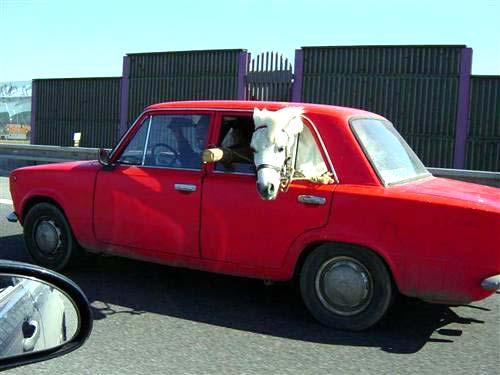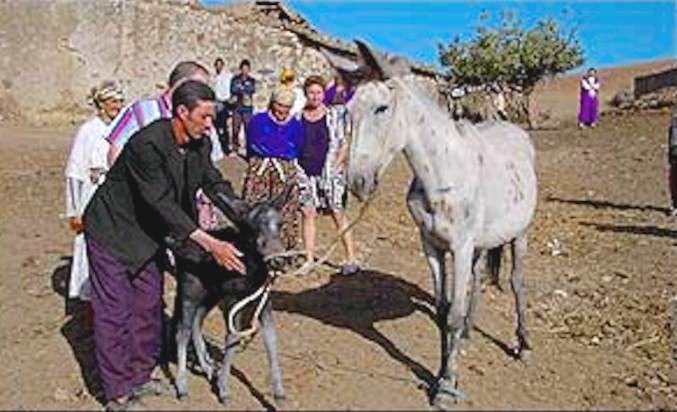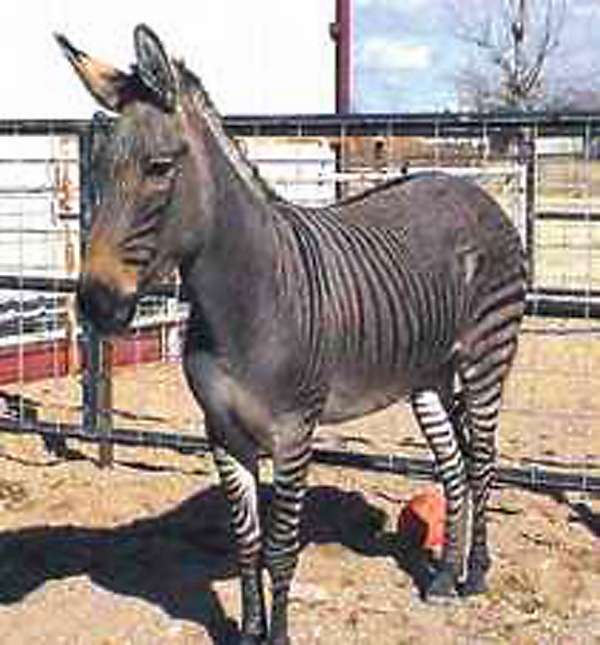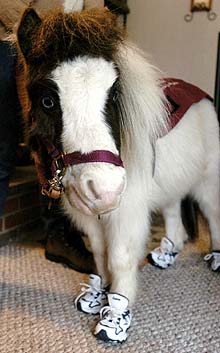On the Hoof
Does Your Car Need More Horsepower?Life is 440 horsepower in a 2-cylinder engine. - Henry Miller
Source: thesun.co.uk sent to them by Tony Seymour. Why do you suppose the licence plate is upside down?
Click to Play
Morocco's Miracle Mule
The miracle mule and its foal: the mule's owner did not realise it was pregnant by Katty Kay A mule has given birth to a male foal in a hamlet deep in rural Morocco. No big deal, you may think, but in fact the birth was a minor scientific miracle. A mule is the hybrid of a horse and a donkey and should be sterile - except in this instance. There have only been two substantiated cases of a mule giving birth in the past quarter century: one in China in 1988 and the other also in Morocco in 1984. Since 1527, (when records began on the issue) there have only been a total of 60 reported cases of mules giving birth. "The occurrence is so historically rare that the Romans had a saying Cum mula peperit, meaning 'when a mule foals', the equivalent of our 'once in a very blue moon'," explained Dr Gigi Kay, a horse vet with the charity the Society for the Protection of Animals Abroad, who has visited the mother and son. The 14-year-old mother mule gave birth on 28 August in a small hamlet of three poor farms in the region of Oulmes, 80 kilometres south of the ancient city of Fez. The farm is nestled at the foot of the Atlas mountains, where the mother mule has become a cult. She and her foal have been visited by streams of people, many of whom travelled for hours to pay tribute to the miracle birth and bring gifts to the owner and the animal. The mule's aged owner, a farming woman whose face is covered in traditional local tattoos, did not realise the mule was pregnant and rode her 20 kilometres to market the day before the birth. Dr Kay is running blood tests on both the mother and the foal. She said the science defied belief. A horse has 64 chromosomes and a donkey has 62, so a mule is left with 63, an uneven number which cannot divide into chromosome pairs. This should make a mule unable to reproduce. The Moroccan foal looks a bit like a baby donkey and a bit like a baby mule - but not exactly like either. Source: news.bbc.co.uk Wednesday 2 October, 2002
Horses usually live to be 25 - 30 years old, donkeys average 30 - 40, niniature donkeys average 25 years, and mules can live into their 40's.
Zonkeys are the result of a cross between a Zebra and a Donkey
Her father is a zebra, her mother a horse. This zorse, resident of a German safari park zoo,
Stroud's Wahoo - a REALLY loud appaloosa saddle mule performing in English Pleasure
On the Hoof
"Horseshoes are sooo last year, Dahling..." New designs are being trotted out for horseshoes. Square toes are in... If tired and aching feet are ever a problem for you, imagine how bad things could get with four feet to look after instead of just two. Researchers in the Structure and Motion Laboratory at the Royal Veterinary College (RVC) in London spend a lot of time thinking about such matters, and at an exhibition held at the Royal Society in London on 6 July, some of them explained the latest developments in equine footwear. A traditional horseshoe is a hard loop of steel that is nailed to the animal's hoof to prevent the horny keratin of which that hoof is made from chipping, cracking or splaying. It is an effective solution, but one that goes back millennia. The RVC is one of many groups that are trying to bring the humble horseshoe into the 21st century. One approach discussed at the exhibition draws on the work of Gene Ovnicek, an American farrier. His work on wild horses showed that their feet tended to wear in four places. That finding led to the development of a square style of horseshoe that has come to be called the Natural Balance Shoe. This was originally designed as a remedial shoe for horses with problem feet, according to Nicola Smith, a research student in biomechanics at the RVC. Such problems might include collapsed heels and weak hoof-horn. The Natural Balance Shoe, though, is causing controversy. In some cases it is starting to replace traditional shoes for normal use. Yet work by the RVC shows that it is not a better shape of shoe for the average horse. The Natural Balance Shoe, in any case, is still made of metal, and one might be forgiven for wondering why horse owners do not just pop their equine pals into a nice, comfy set of running shoes instead of all this business with nails. Part of the reason, according to Miss Smith, is that on many surfaces rubber-soled shoes would be no use. When a horse is galloping, its hooves hit the ground at about 15kph, and this causes damaging vibrations in the animal's legs. One way of reducing these vibrations is to allow the hooves to skid a bit when they hit the ground. Rubber-soled shoes will skid on grass, but on most other surfaces they tend to develop too much friction. That does not mean, however, that you have to stick with traditional (or even Natural Balance) horse shoes. Shoes made of hard plastic may improve matters, especially as they can be glued rather than nailed on to hooves. So, for horses that spend a lot of time walking on artificial surfaces such as tarmac, the RVC is currently experimenting with plastic shoes that have tungsten carbide surfaces to provide the right amount of friction. One of the most innovative versions of a plastic shoe is the Imprint Therapeutic Shoe, made by Andrew Poynton, a high-tech farrier who works in Malmesbury, England. Mr Poynton's shoe is made of mouldable plastic. To fit it to a horse you warm it up to soften it, and mould it around the animal's hoof. Then you set it solid by chilling it with an aerosol. Like all high fashion, such shoes are expensive. In Britain, traditional shoeing costs about £70 ($130) an animal. Fitting your nag with Imprint Therapeutics on all feet could set you back £400. But for the fashionistas of the equine world, it may be worth it. Source: economist.com July 8 2004 photos credit Associated Press
For more on animals, including reptiles, crustaceans, arachnids, insects, fish, birds, pets, livestock, rodents, bears, primates, whales and Wellington's waterfront, click
"Up" below to take you to the Table of Contents for this Animals section. |
 Animals
Animals Animation
Animation Art of Playing Cards
Art of Playing Cards Drugs
Drugs Education
Education Environment
Environment Flying
Flying History
History Humour
Humour Immigration
Immigration Info/Tech
Info/Tech Intellectual/Entertaining
Intellectual/Entertaining Lifestyles
Lifestyles Men
Men Money/Politics/Law
Money/Politics/Law New Jersey
New Jersey Odds and Oddities
Odds and Oddities Older & Under
Older & Under Photography
Photography Prisons
Prisons Relationships
Relationships Science
Science Social/Cultural
Social/Cultural Terrorism
Terrorism Wellington
Wellington Working
Working Zero Return Investment
Zero Return Investment





